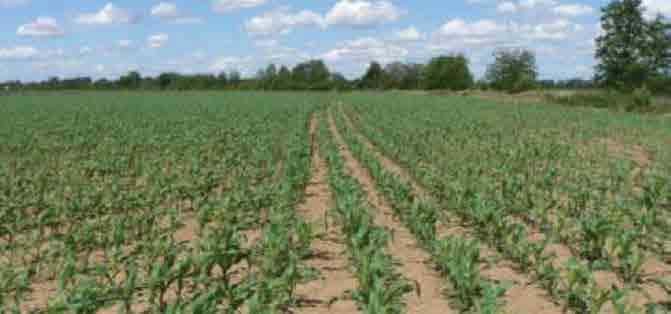Automatic Section Control Technology - Precision Row Crop Planting

Automatic section control (ASC) technology for planters has gained interest among growers because of its potential savings and other benefits. Automatic section control is also referred to as auto-swath or row clutches when talking about planters. As the name suggests, this technology improves planting efficiency by automatically turning OFF planter sections or individual rows in areas that have been previously planted (e.g., headlands or point rows) or areas designated as no-plant zones (e.g., grassed waterways, terraces, outside a field boundary).
ASC can also automatically turn sections or rows back ON when the planter moves into an area to be planted. Figure 1 illustrates a manually controlled planter by the tractor operator versus an ASC-equipped planter with individual row control and section control. Without ASC, the operator would typically need to decide when to stop planting and would plant into the previously planted area to ensure 100 percent coverage. Figure 1(a) also shows that the decision time to stop planting can also play a role in the total double-planted area. With ASC, the decision-making is handled within the technology either in sections or individual rows as illustrated in figure 1(b). Figure 2 shows the results of reducing double-planted areas using ASC and, thereby, providing direct-seed savings.
Currently, equipment manufacturers are offering ASC technology as an option on new planters. Third-party companies also provide add-on options. The technology can be installed on some older planters. Consult an equipment manufacturer or third-party vendor to determine compatibility of the ASC technology for the specific planter model. Several benefits beyond seed savings exist for ASC, but it is important to understand the components and their functionality in order to maximize benefits at the farm level.
Benefits
The primary tangible benefit of using ASC on planters is the seed savings through reduction of double- and triple-planted areas of the field. A two-year study conducted in 2010 and 2011 using the Alabama Agricultural Experiment Station at Auburn University reported input savings ranging between 1 percent and 12 percent per field with an average savings of 4.3 percent on seed cost for a farm when using ASC. This study only considered the benefit of ASC on seed savings and not the advantages of savings gained using guidance technology. Using guidance technology with ASC could increase overall seed savings to between 3 percent and 35 percent on a per field basis. These savings depend on field size and shape with higher benefits occurring in large, irregular-shaped fields or fields containing conservation management structures, such as grass waterways and terraces.
Automatic section control on planters can also improve yield and reduce harvest loss. A two-year study at Auburn University indicated that ASC on planters can increase both cotton and corn yield while also reducing harvest loss compared to double-planted areas. This study investigated double-planted areas at different angles (30 degrees, 60 degrees, and 90 degrees) versus single-pass areas. Population and yield data were collected for both crops with only harvest loss measured in corn when using a combine. Yield results indicated a significant difference ( p,0.001) between single-pass and double-pass areas for both cotton and corn. The average yield loss across all double-planted treatments was 21 percent in cotton and 17 percent in corn. In terms of harvest loss, there was an average 8.7× loss factor in double-planted areas for corn so a 1 bu/ac nominal combine loss would be 8.7 bu/ac (8.7 × 1 bu/ac). The 60-degree angle had the highest loss factor of 10.6×. A couple of observations were made over this two-year study in corn. Smaller ears were found in double-planted areas (Figure 3), while the corn header tended to push corn stalks down in these areas generating the higher harvest losses. Additionally in 2011, higher in aflatoxin levels were observed in double-pass areas.
In summary, ASC can provide several benefits:
- Reduced overlap areas leading to cost savings on seed (as discussed above)
- Improved overall planter efficiency
- Improved environmental stewardship
- Increased operator visibility during harvest (able to see rows clearly) leading to increased field efficiency (especially at night)
- Reduced operator fatigue by not having to manually turn the planter ON or OFF over a full day.
- As-planted maps for field documentation, record keeping, and use in farm management information systems (FMIS) or other ag data management services
ASC Decision Support Tools
Two online tools can be used to help evaluate the potential value of ASC and help with purchase decisions. The first is the PrecisionAg Institute’s Profit Calculator available at www.precisionag.com/ profit-calculator/. This calculator focuses on the value of guidance and ASC taking into account attributes such as field shape and size along with financial costs. Instructions, both written and video, are provided to help step through the setup for various field equipmen t(e.g., sprayer, planter, and fertilizer). Outputs include return on investment (ROI) for both guidance and ASC, providing expected payback time period.
The second tool was developed by the University of Tennessee and focuses directly on ASC technology for planters. This interactive computerized decision aid is called the Automatic Section Control for Planters Cost Calculator (ASCCC). A downloaded Excel file allows you to customize the setup for your particular farm, including specifying input costs, crop prices, and yield. You can download and review information at http://economics.ag.utk.edu/asccc.html. Outputs from this tool include seed savings, yield benefit, and payback time in years
Summary
ASC technology has become a popular option on new row crop planters and as outlined in this article can provide substantial seed savings and other benefits. The decision to incorporate ASC should be carefully evaluated to determine if it fits in with your operation.
Used with permission of the Alabama Cooperative Extension System (Alabama A&M University and Auburn University). All rights to the original material are reserved by the Alabama Cooperative Extension System. More information is provided at www.aces.edu.

